Odoo - Product Vision
Odoo is a web-based software platform that provides a large set of different applications for business management. For example, Odoo can be used for website building, warehouse management, project management, and much more. The platform is developed by both a company by the same name and an active community. While the software suite can be used for free, the company also provides enterprise versions of their software with additional proprietary features. The Odoo project aims to achieve business software that is “intuitive, full-featured, tightly integrated, effortless to upgrade, all while running smoothly for every business, every user” 1.
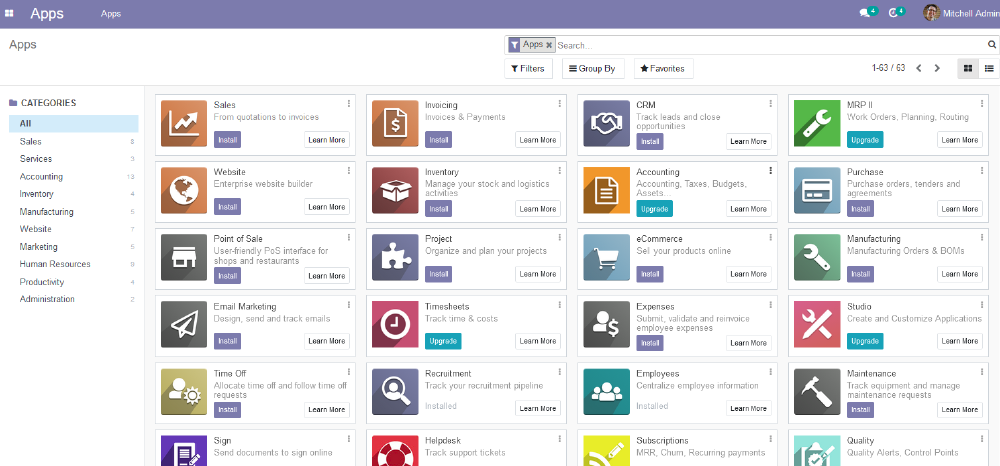
Figure: Apps can be installed using the admin panel.
Odoo started as an open-source enterprise resource planning (ERP) suite - a collection of applications that help manage and integrate different parts of a business/organization within a single system. ERP tools were initially used by large businesses2. However, with the advent of open-source ERP systems, small and medium-sized enterprises also started to use ERP systems2. That is also one of the points of focus of Odoo: making “time, startup and maintenance costs are much lower” 3.They achieve this by building an easy to set up ERP suite that can be easily hosted on the cloud. Over the years, Odoo created different products (e.g. Odoo Website) outside of the typical management style ERP applications. However, all of them aim to help companies to more efficiently digitalize their business.
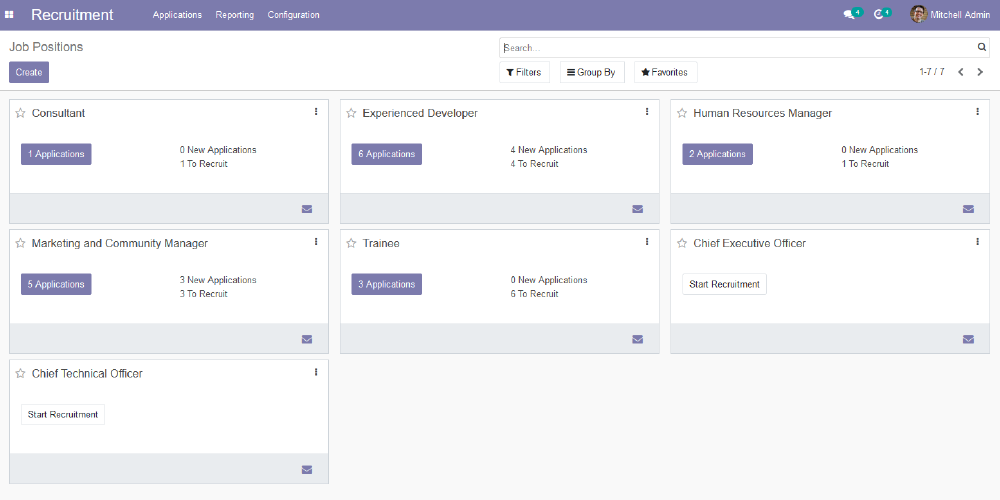
Figure: Odoo Recruitment assists HR department in recruiting new employees.
Context
ERP is a general name for applications helping companies to manage their assets. Assets can possibly describe everything here, for example: company vehicles, documents, invoices, money or even human resources. Odoo addresses this problem by supplying a set of integrated tools that each solve typical management problems of a given department and all together can solve company-wide issues. Examples of such tools are Accounting, Sales, Invoicing or Recruitment.
Odoo can either be cloud hosted (and used in SaaS model), or hosted privately on premise. The first one offers a great opportunity for startups and small companies without IT departments to use professional tools from the start. The latter offers a cheaper solution compared to well-known ERP systems, but requires an IT department to run it. Going for an open-source solution is also a better option compared to building a new system when a company is forced to host its own services due to legal matters (e.g. GDPR, PCI DSS). Finally, using an open-source solution over monetized services is preferred in companies where full control over the code that they’re running is required.
Odoo is an underdog in its domain. Its main competitors are SAP (which is frequently ranked in the top 10 biggest companies in IT), and Oracle NetSuite (which has been in business since 1998). Because it’s difficult and costly to move from one ERP to another and people tend to go for what they’re familiar with, Odoo has difficulties entering the market. However, Odoo receives plenty of help from its community built around open-source and transparency. In addition to that Odoo started creating tools to create eCommerce, eLearning and general websites. These products have to be bought separately with ERP systems in most cases, which gives Odoo the advantage of having them integrated.
Domain Model
The Odoo suite is a large software system, and describing its domain model would result in a more general description of a domain model rather than one that is specific to an application. Businesses deal with an increasing amount of complexity in all aspects relevant to their operation and more importantly, their success. Businesses require payroll and accounting software to keep track of their finances and billings. They require Customer Relationship Management (CRM) tools to manage clients and relationships. They require project management tools so that they can successfully realize products for their customers. And they require many more tools related to finance, sales, marketing, web presence, inventory tracking, productivity, and Human Resources Management (HRM). This is the domain in which Odoo operates and exactly where it provides its value to users (in particular, the businesses). All of these tools are essential to running a modern-day business and hence Odoo is able to provide valuable tools to its users to address their business needs.
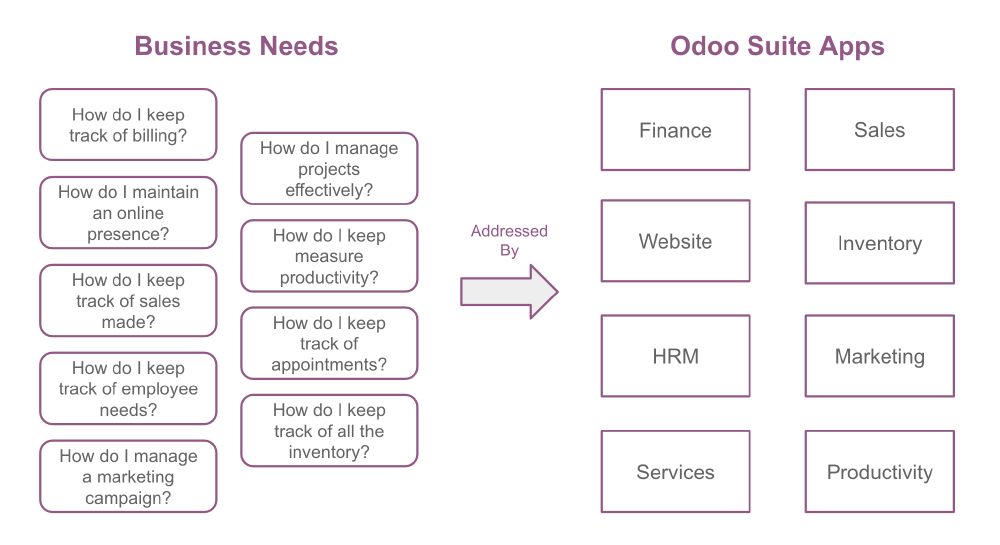
Figure: The relationship between business needs and the Odoo Suite Apps
Domain experts have to know what features are required by the businesses. Specifically, they know how features should look, and how users can use them. As such, the domain experts for Odoo are user interface and user experience designers, who represent the future users of this tool, and senior developers, who have encountered the features and know what the problems are when implementing them.
Stakeholders
A map with the stakeholders is made in the figure below. Here, the stakeholders are divided into three categories: (end) users, business, development and operations.
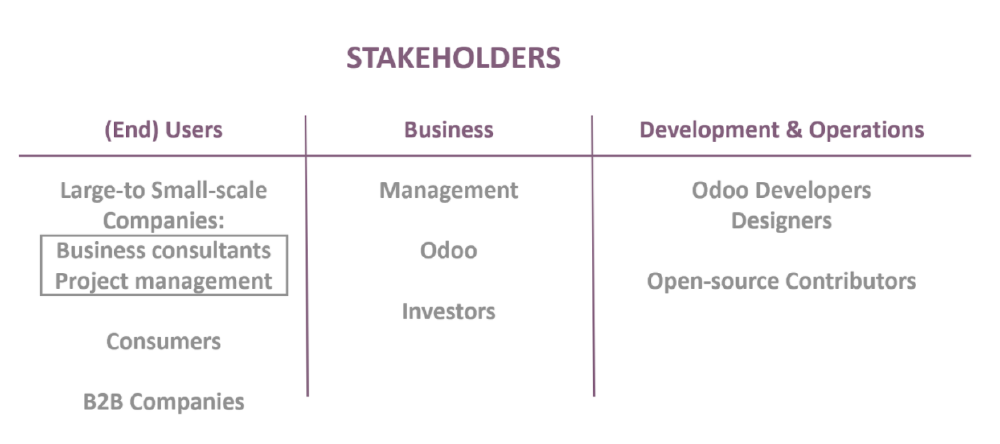
Figure: Odoo ERP stakeholders
Users
As described earlier, the Odoo ERP suite can be used by companies of various sizes. The wide range of offered services fits companies in many industries and different departments, (e.g. business consultants and project managers). It’s important to note that users of Odoo extend further to users of users (i.e. to users of clients of Odoo) since companies will use Odoo’s products only if they can be used to create a suitable experience for their clients. As such Odoo employees have to think ahead while developing products on how these products will be used. These indirect users could also be companies, mainly B2B businesses. This aspect is depicted in the figure below with a distinction between the direct clients and the end users.
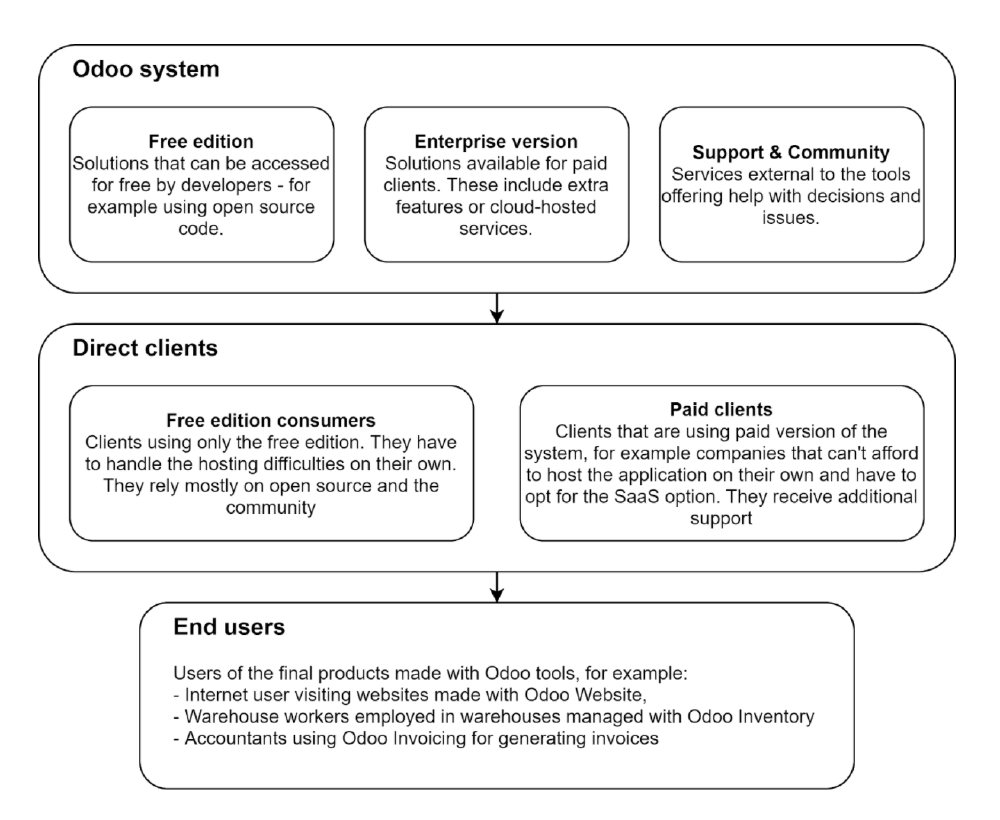
Figure: Odoo system and its users
Business
The businesses are mainly concerned with creating a sustainable company. This is mainly of concern for the management and different departments of Odoo, who provide an enterprise version of the software. But also investors such as Summit Partners4, who are also involved with the project.
Development & Operations
In order to ship, sell and develop the product, Odoo has a lot of employees. They are mainly concerned with keeping the development and business sustainable. While a lot of developers are hired by Odoo, there are also open-source contributors involved in the development of the project. Community can also contribute by helping each others on forums or reporting issues.
Key quality attributes
As was discussed in the previous section, In order to incorporate Odoo’s ERP suite in a company, it has to meet a few key quality attributes:
- Usability
Since the software is designed for a large group of customers, the software needs to be easy to use. A small learning curve makes it easier to employ in business environments. - Customizability
The software has to be customizable, to fit large businesses and domain-specific aspects of certain businesses that deploy the ERP suite. - Extensibility/Modularity
The foundation of Odoo lies in the addition of add-ons and new features. Open-source contributors develop new add-ons that add functionality to existing modules or add new modules altogether. This modularity is also useful for contributors, making the architecture and different parts of the software easier to understand. - Correctness/Reliability
The software has to produce correct information because some data could be the basis of decisions within companies. It is therefore necessary that the output of the system is correct. Another important quality attribute is reliability, as the use of Odoo expands to multiple departments of a business. This means that the whole system has to be constantly up and running.
Ethics
Odoo’s software is open source, which means that end users can (to a certain extent) verify what happens with their data. This can, however, be cumbersome and moderating this should not be the task of the end user. Odoo is being used by many companies and with a great amount of users comes great responsibility. This section will cover the ethical issues that Odoo has to deal with. They are divided into three categories: Security and privacy of stored data, data handling and responsibilities towards clients.
Security and privacy of data
A lot of the data that is stored and handled at Odoo could be abused by malevolent parties. The amount of data is large and there are many possibilities of abusing it. This makes Odoo a target for possible attacks. In order to make sure this data stays safe, it is important for them to have excellent security in place. In addition, when a company decides to make use of Odoo, they expect their data to be private and only accessible to them. Odoo should make sure that only people with approval should be able to access company data. Failure to do so could negatively impact the company to which the data belongs to.
Data handling
Since the data is used by active clients, another big consideration for Odoo is data handling. Data should always be accessible to their users (unless clearly stated otherwise) and may under no circumstances be lost.
Responsibilities towards clients
Companies that make use of Odoo often use their services for critical parts of their business processes. This means that the way Odoo changes its software can directly impact the success of these companies. They, therefore, bear an immense responsibility to always keep the quality of their software top tier.
Roadmap
While there is not much information available about specific expected features, Odoo follows a strategy in order to bring more value to users. This strategy is focused on four major points: increasing accessibility, improving their framework, allowing users to be more efficient and integrating user feedback.5
- Increasing accessibility
Localization and cost of services are two important factors for Odoo’s accessibility. By increasing the number of countries they support and lowering the prices for their services, Odoo aims to make their software more accessible for potential users. - Improving their framework
Odoo’s software benefits greatly from cross-app integration and how easy it is for developers to extend the system. By increasing these benefits, they ensure smoother development of new features and improved user experience when using multiple products. - Allowing users to be more efficient
The main goal for Odoo is to allow users to add more value in a smaller amount of time. This requires them to have a high business scope and high user-friendliness. To work towards this goal, Odoo focuses on adding useful features, improving existing software and providing more user support - Integrating user feedback
Most importantly, Odoo tries to listen to what its users have to say; they value feedback from their end users highly. This feedback then gets checked in order to make sure that implementing the feedback is worth the effort. The ultimate goal is to make giving feedback easier, more frequent and make it fulfil the requirements above.
Every year, Odoo releases a new version of their software. Their next version, Odoo 15, will be released October 2021. The updates and new features that will be added will be made with Odoo’s current strategy in mind.
Conclusion
To summarize, Odoo is an ambitious project that provides a variety of tools that ease the workflow of small to large businesses. As a free open-source alternative to ERP software, Odoo provides a lot of freedom due to its extensibility. Making it easy to add new tools inside the existing framework. A stakeholder analysis was given to sketch possible users and parties involved with the Odoo project. In addition to that, we described the ethical concerns that may arise. Since Odoo deals with a lot of company data, the developers have to keep privacy and security issues in mind.
-
Odoo. (n.d.). About Us - Odoo. Odoo S.A. Retrieved 1 March 2021, from https://www.odoo.com/page/about-us ↩︎
-
Ganesh, A., Shanil, K. N., Sunitha, C., & Midhundas, A. M. (2016, February 1). OpenERP/Odoo - An Open Source Concept to ERP Solution. ResearchGate. https://www.researchgate.net/publication/306301008_OpenERPOdoo_-_An_Open_Source_Concept_to_ERP_Solution ↩︎
-
Odoo. (2018, June). ERP Comparison Whitepaper: Microsoft Dynamics, NetSuite, & Odoo. https://odoocdn.com/openerp_website/static/src/pdf/erp_comparison_en.pdf ↩︎
-
FinSMEs. (2019, December 18). Odoo Raises $90M Investment Led by Summit Partners. https://www.finsmes.com/2019/12/odoo-raises-usd90m-investment.html ↩︎
-
Odoo Experience 2019 - Odoo 14 Roadmap - Odoo S.A. Retrieved 19 March 2021, from https://www.youtube.com/watch?v=I-F3AgobRQg ↩︎